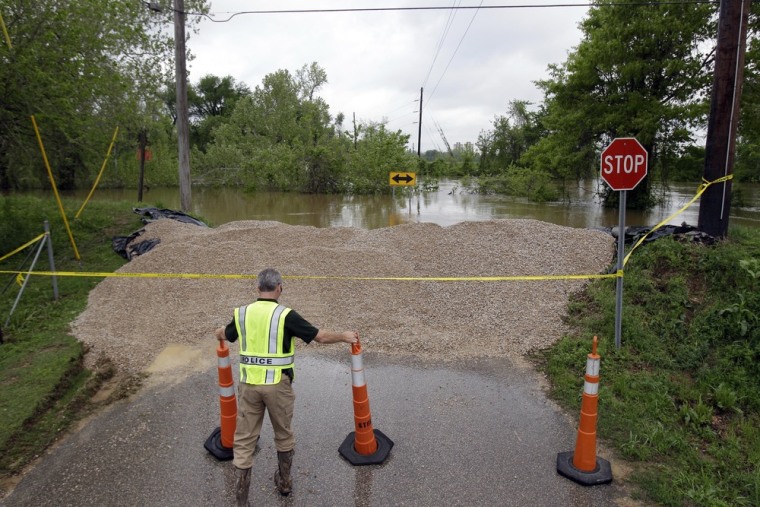A levee keeping a swollen river from inundating a southeast Missouri town breached in at least one place downriver on Tuesday, but water pouring through the crack was unlikely to force the further mass evacuation of homes in the area, authorities said.
Crews were also looking into reports of another breach in the levee protecting Poplar Bluff and the surrounding area along the Black River from major flooding, police officer Daron House told The Associated Press.
The breach happened southeast of Poplar Bluff, in an area that's not heavily populated, Butler County Sheriff Mark Dobbs said Tuesday. The water was pouring into a drainage ditch along a road, and even it if topped the ditch, was unlikely to cause enough backflow to threaten Poplar Bluff homes upstream, he said.
In another area near the confluence of the swollen Mississippi and Ohio rivers, authorities debated a desperate plan to use explosives to blow a 2-mile-wide hole through a levee to ease the pressure on others.
A powerful storm system moving through the Midwest dumped several inches of rain on already-swollen rivers and spawned at least one tornado that killed four people and carved a wide swath of destruction through the town of Vilonia, Arkansas.
Poplar Bluff deputy police chief Jeff Rolland said Tuesday that more than 6 inches of rain fell on the town on Monday, bringing the four-day total in the area to 15 inches and causing the Black River to pour over the levee in 30 places, from Poplar Bluff to the town of Qulan, downriver.
Rolland said street department workers hurriedly filled small boats with sandbags overnight and were able to sure-up a vulnerable section of the levee. Crews rescued 59 people in an hour-and-a-half late Monday after water spilled over the dam.
Despite the punishment the region has already endured, the weather was expected to get worse — and soon. Another line of storms moving through Oklahoma and Texas carried the same threat of tornadoes and flooding but over a broader area that stretched from Dallas to Louisiana and up to Memphis.
Greg Corbin, the warning coordination meteorologist for the National Weather Service's Storm Prediction Center in Norman, Okla., said having two systems develop back-to-back is unusual.
"It's basically in the same place for two days in a row," Corbin said. "That doesn't happen very often. Such rapid succession doesn't give any time for a break.
'Ten times worse than it ever has been'Poplar Bluff resident Corey Brown, a regional project administrator for five counties in Missouri, was in the process of requesting flood assistance from FEMA when the levee protecting the town breached.
“Almost all of our counties are having flash flooding, or the rivers are high,” he told msnbc.com. “They’ve been dealing with floods, but now it’s just ten times worse than it ever has been.”
Brown said his drive to work, normally a 15-minute commute, took an hour due to so many road closures and stranded cars, which he posted photos of on his Twitter page.
Much of the area was at a standstill, Brown said, with factories closed and evacuees gathered in the town’s coliseum.
“The whole town is pretty much coming together to help each other out,” he said. “People are bringing fans, and food, and shelter for dogs. It’s pretty amazing.”
'Too dangerous to sandbag'
Families forced to flee their homes Monday watched as murky floodwater began creeping into their yards and homes. If the levee were to give way completely, many of those homes would be left uninhabitable. Sandbagging wasn't an option — the river simply rose too quickly.
"By the time we realized what was happening it was too dangerous to sandbag," Butler County Presiding Commissioner Ed Strenfel said.
Severe storms that began early last week have hammered a swath of the nation's midsection without letup. Again Monday, powerful storms ravaged Missouri, Arkansas, Kentucky, Texas, Tennessee and other states. Authorities said at least 10 people were killed in Arkansas — three of them when floodwaters swept two vehicles off of roadways and four when a twister tore through Vilonia.
The storm system was expected to move into Illinois and Wisconsin on Tuesday, said Greg Carbin, a meteorologist with the Storm Prediction Center in Norman, Okla. At the same time, a second storm system will start along the same path, meaning several more days of rain. That system will continue east through Thursday, he said.
Governors in both Arkansas and Kentucky declared states of emergency. In Kentucky, historic flooding is expected over the next few days, partly because of a double-whammy — both the Ohio and Mississippi rivers significantly above flood stage. Several dozen residents were evacuated near the confluence of the rivers at Cairo, Ill.
The Army Corps of Engineers postponed its decision on a proposal to blow a huge hole in the Birds Point levee in southeast Missouri, just downriver of the confluence. The idea was hatched as a desperate bid to reduce the amount of water moving down the Mississippi.
Gov. Jay Nixon opposed the plan, which would soak 130,000 acres of farmland — an area stretching 30 miles north to south and as much as 8 to 10 miles wide.
The state attorney general filed a lawsuit Tuesday in federal court seeking to block the demolition, arguing that the floodwaters could damage 100 homes and leave behind a layer of silt that could take a generation to clear.
Missouri was still cleaning up from tornado damage in the St. Louis area — 2,700 buildings, including Lambert Airport, were damaged in the Friday night twister — when spring flooding went from bad to far worse Monday.
A dam in St. Francois County was in jeopardy of bursting, with a few dozen homes potentially in harm's way. Levees were stressed along the Mississippi River in Pike and Lincoln counties, north of St. Louis.
